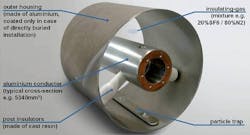Siemens Develops Gas-Insulated Transmission Line for Direct Current
Berlin Technical University and Dresden University of Applied Sciences, among others, are working under the lead management of Siemens on developing a new gas-insulated DC transmission line known as the DC CTL (Compact Transmission Line for Direct-Current High Voltage) for laying underground. The new line is designed to transmit up to five GW of power per system. The German Federal Ministry for Economic Affairs and Energy (BMWi) is providing €3.78 million in this development project.
The DC CTL will be based on the technology of the existing gas-insulated transmission line (GIL), which consists of two concentric aluminum tubes. A mixture of gases is used as the insulating medium. Until now, the GIL has only been available for alternating current. The challenge for the DC CTL is posed by the special design of the components taking into account their specific properties at high direct voltages. Because of its significantly higher current carrying capacity of up to 5000 A, the DC variant of the GIL would not only be able to transmit the required amounts of electrical power more efficiently compared with cable in the future grid upgrade; it would also make power transmission routes more environmentally compatible as well as cheaper.

